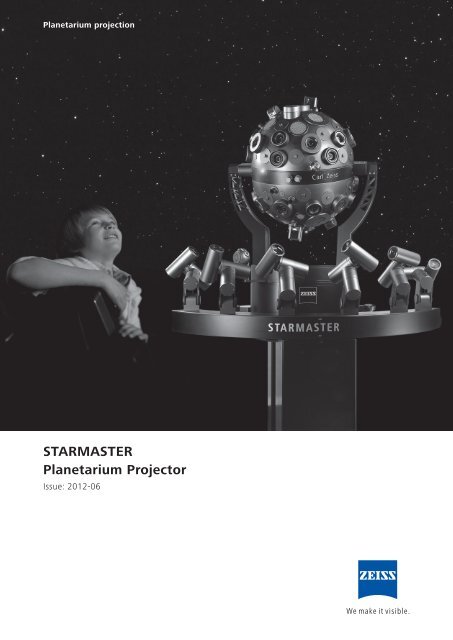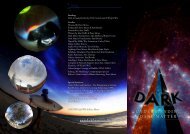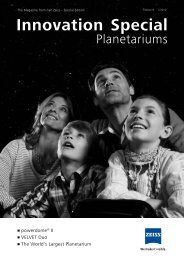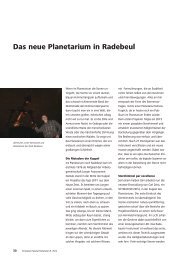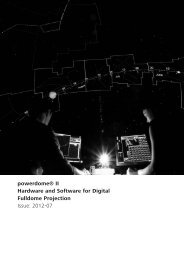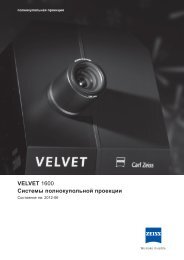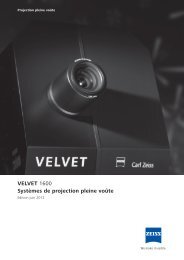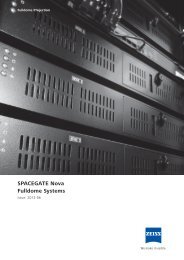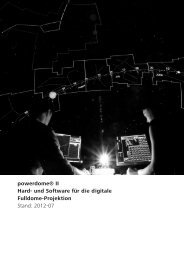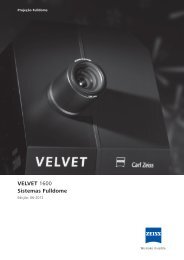STARMASTER Planetarium Projector - Carl Zeiss Planetariums
STARMASTER Planetarium Projector - Carl Zeiss Planetariums
STARMASTER Planetarium Projector - Carl Zeiss Planetariums
Create successful ePaper yourself
Turn your PDF publications into a flip-book with our unique Google optimized e-Paper software.
<strong>Planetarium</strong> projection<br />
<strong>STARMASTER</strong><br />
<strong>Planetarium</strong> <strong>Projector</strong><br />
Issue: 2012-06
The natural depiction of the night sky<br />
<strong>STARMASTER</strong> in the 18-meter dome of the<br />
Asahikawa Science Center, Japan<br />
Starry sky<br />
9,100 stars up to 6. m55 99 % of all projected stars appear<br />
below the resolution of the human eye<br />
Milky Way: brightness can be controlled<br />
seperately from stars<br />
2<br />
<strong>STARMASTER</strong> is the <strong>Carl</strong> <strong>Zeiss</strong> planetarium<br />
projector for domes of medium<br />
size.<br />
Radiant stars, as breathtaking as in<br />
nature: optical-mechanical projectors<br />
by <strong>Carl</strong> <strong>Zeiss</strong> are distinguished by the<br />
precise simulation of the natural night<br />
sky.<br />
With a limiting size of 6. m 55, the same<br />
number of stars visible to the unaided<br />
human eye is shown under optimal<br />
observation conditions and in space.<br />
No more, no less.<br />
ZEISS fiber optics provides a brilliant<br />
representation of the stars: a high<br />
level of brightness combined with<br />
small diameters. The starry sky does<br />
not fade out when a video projection<br />
is launched. <strong>STARMASTER</strong> is the ideal<br />
optical-mechanical partner for combinations<br />
with the <strong>Carl</strong> <strong>Zeiss</strong> fulldome<br />
systems such as powerdome®VELVET.<br />
High-output LEDs are the light source<br />
for the stars. They produce pure white<br />
light so that all of the stars shine in<br />
natural white. But the light spectrum of<br />
the LED also makes it possible to filter<br />
out reddish, yellowish and bluish star<br />
colors. Thus, the bright stars are shown<br />
in their true colors.<br />
A scintillation device generates an<br />
artificial flickering of the stars which<br />
appears as natural as the real thing,<br />
and includes all stars, not merely some<br />
of the bright ones.<br />
The use of the latest technology facilitates<br />
such an excellent representation<br />
of star clusters and nebulas that you<br />
can view them with binoculars. The<br />
accurately detailed projection includes<br />
weaker stars (for star clusters) and actual<br />
structures (galaxies and nebulae).<br />
<strong>STARMASTER</strong> is available in various<br />
versions. You decide whether you<br />
want to integrate Sun, Moon, planets,<br />
constellations, didactic projectors<br />
(astronomical grids, scales, markings)<br />
and additional effect projectors in your<br />
optical-mechanical system.
Model variations<br />
<strong>STARMASTER</strong> can be configured to<br />
meet your requirements. The star field<br />
and the white and blue effect lighting<br />
for dome brightening and twilight are<br />
basic features. All versions can be coupled<br />
directly and synchronously with a<br />
powerdome system by <strong>Carl</strong> <strong>Zeiss</strong>.<br />
<strong>STARMASTER</strong> Superior with<br />
the full range of features<br />
and substructure cabinets<br />
<strong>STARMASTER</strong> Superior is the fully<br />
configured version. If you are considering<br />
the combination with a fulldome<br />
system, certain projections can be<br />
adopted from the digital system.<br />
These functions can be omitted in the<br />
<strong>STARMASTER</strong> equipment.<br />
The <strong>STARMASTER</strong> Classic version is<br />
designed for presenting the stars alone.<br />
Further configuration versions include<br />
projectors for Sun, Moon and the<br />
planets.<br />
<strong>STARMASTER</strong> Attraction, starball version<br />
with projectors for Sun and Moon on<br />
substructure column<br />
Model variations Starry sky Sun, Moon Planets Didactic<br />
projections<br />
Substructure<br />
<strong>STARMASTER</strong> Classic x – – – column<br />
Attraction x x – – column<br />
Premium x x x – double cabinet<br />
Superior x x x x1 double cabinet<br />
1) selectable<br />
3
The Starball<br />
Stars<br />
The twelve wide-angle projectors making<br />
up the night sky are fitted in the<br />
starball. Sirius, Canopus and the brightest<br />
nebulae are presented by special<br />
projectors. Two further projectors deliver<br />
a realistic picture of the Milky Way.<br />
Sun and Moon<br />
The projectors for Sun and Moon are<br />
integrated in the starball. They are<br />
positioned independently of each other<br />
via the astronomical algorithms in the<br />
control software.<br />
The moon phase mechanism shows<br />
even very small crescents in the immediate<br />
vicinity of the Sun. The midnight<br />
sun can be portrayed without obstruction.<br />
The sun projector includes an integrated<br />
sun eclipse mechanism with a<br />
total, a ring-shaped and several partial<br />
eclipses. In addition, a planet transit<br />
and a reduced sun image for space<br />
travel effects can also be demonstrated.<br />
Furthermore, you can use the sun<br />
projector to present the gegenschein<br />
(counterglow) - a weak circle of light<br />
projected opposite to the Sun.<br />
4<br />
<strong>Projector</strong> for the Sun<br />
<strong>Projector</strong> for the Moon<br />
Sun<br />
Brightness to cast shadows<br />
Solar eclipses<br />
Planet transit<br />
Reduced sun image<br />
Gegenschein (counter glow)<br />
Moon<br />
Brightness to generate a full moon<br />
atmosphere<br />
Visible surface details<br />
Astronomically correct phase change<br />
Automatic image rotation<br />
True-to-life slender crescent<br />
Didactic Projections<br />
The projectors for the constellations of<br />
the northern and southern hemispheres<br />
are attached to the starball as well.<br />
The great circles of equator and ecliptic<br />
can be projected alternately with the<br />
zodiacal constellation figures.<br />
All constellations and zodiac figures<br />
are included in the movements of the<br />
firmament. Their designs are based on<br />
classical, historical models.
Constellation figures<br />
Separate projection of the zodiac<br />
figures and northern/southern<br />
constellations<br />
Groups of figures are distinguished<br />
by color<br />
Great circles<br />
Meridian<br />
Celestial equator und ecliptic<br />
90° hour circle<br />
180° vertical circle<br />
Scales and Markings<br />
Azimuth scale and zenith mark<br />
Hour angle scale and celestial pole<br />
Precession scale and pole of ecliptic<br />
Shutter and Motion Control<br />
The starball has three vertical motion<br />
axes which are located above each<br />
other. Rotations about these axes enable<br />
any astronomic motion process.<br />
The real axes are arranged in such<br />
a way that they correspond to the<br />
diurnal motion, the change of the polar<br />
altitude and the azimuth rotation. The<br />
combined motion permits the generation<br />
of any desired virtual axes, e.g. for<br />
the representation of precession, the<br />
rotation about any desired celestial<br />
pole or the presentation of celestial<br />
motions on other bodies of the solar<br />
system.<br />
Fading out of projections for the<br />
heavens on the dome horizon is accomplished<br />
by means of computercontrolled<br />
fixed star shutters. For<br />
installation in tilted auditoriums the<br />
other projectors on the starball are also<br />
equipped with computer-controlled<br />
shutters instead of gravity shutters. The<br />
advantages: the level of the horizon<br />
can be adjusted via the programming;<br />
panoramic projections and night sky<br />
projections adapt to one another;<br />
individual star fields can be faded in or<br />
out as well.<br />
5
Planet <strong>Projector</strong>s and Additional Equipment<br />
Planet projectors with LED light sources<br />
6<br />
The Planet <strong>Projector</strong>s<br />
Six projectors with two separately<br />
controllable axes each are provided for<br />
presenting the planets and other solar<br />
system bodies. Installed on a support<br />
immediately in front of the starball,<br />
they generate nearly starshaped light<br />
dots which are set to the respective<br />
required brightness level. Mars appears<br />
in its typical reddish tint.<br />
By means of the software, planet<br />
projections are included in topocentric<br />
and other motions. The revolution of<br />
the planets about the Sun can also be<br />
simulated (orrery projections).<br />
The planets are illuminated with extremely<br />
durable high-output LEDs.<br />
Additional Equipment<br />
Upon request, <strong>STARMASTER</strong> can be<br />
equipped with a built-in lifting device.<br />
This lowers the starball from the center<br />
of the dome, thus facilitating shadowfree<br />
projection from the edge of the<br />
dome across the center of the dome.<br />
A shooting star projector is available<br />
as an option. It not only shows single<br />
meteors but also showers.<br />
Planets<br />
Mercury, Venus, Earth, Mars, Jupiter<br />
and Saturn (default setting)<br />
Brightness / color tint true-to-life<br />
Independent control about two axes<br />
Topocentric presentations
The Control System<br />
All axis positions, brightness values and<br />
other functions are calculated in real<br />
time and can be controlled manually.<br />
The correct astronomic parameters are<br />
taken into consideration in the calculations<br />
for the positioning, speed changes<br />
and brightness variations, in order to<br />
achieve exact positioning of the starry<br />
sky and the solar system within a time<br />
frame of ±10,000 years.<br />
The current software supports topocentric<br />
projections with all motion options<br />
(diurnal motion, annual motion,<br />
precession, azimuth rotation, change in<br />
pole altitude).<br />
Despite all of this, the operation is<br />
simple. Programming skills are not<br />
required thanks to the graphic user<br />
interface in conjunction with the ergonomic<br />
layout of the operating panel.<br />
All operating modes and functions can<br />
be used simply by clicking on them<br />
with the computer mouse.<br />
The operating panel is roughly the size<br />
of a computer keyboard and suffices<br />
for all functions. This panel permits you<br />
to carry out operations in real time and<br />
interactively with the spectators.<br />
There is no restriction on manual oper-<br />
ation, but in many cases the programs<br />
are automated. The automatic run<br />
function can be used independently or<br />
synchronized with other systems, e.g. a<br />
sound source or other computers.<br />
<strong>STARMASTER</strong> can be combined with<br />
any <strong>Carl</strong> <strong>Zeiss</strong> powerdome fulldome<br />
system. The digital planetarium functions<br />
meticulously follow the starball<br />
motions.<br />
The operating system, based on Microsoft<br />
Windows ® , is configured so that<br />
upon agreement remote diagnoses, the<br />
exchange of control data and software<br />
updates can be accomplished over the<br />
Internet.<br />
The operating panel for the manual control of the<br />
ZEISS planetarium systems.<br />
7
Specifications<br />
8<br />
<strong>STARMASTER</strong> <strong>Planetarium</strong><br />
Operating unit<br />
Auditorium<br />
Electrical power supply<br />
<strong>Carl</strong> <strong>Zeiss</strong> AG<br />
<strong>Planetarium</strong> Division<br />
07740 JENA, GERMANY<br />
Version Superior/Premium Attraction/Classic<br />
Dome diameter 14 m – 20 m (46 ft – 66 ft) 14 m – 24 m (46 ft – 79 ft)<br />
Dome tilt 0° to 30° 0° to 30°<br />
Max. height 2730 mm 2730 mm<br />
Mounting surface substructure 424 mm x 1945 mm Ø 780 mm<br />
Starball diameter 750 mm 750 mm<br />
Max. diameter 2080 mm 1080 mm<br />
Height of horizon 2200 mm 2200 mm<br />
<strong>Projector</strong> lift (Option) 650 mm 530 mm<br />
Weight max. 850 kg max. 400 kg<br />
Starball/planet illumination LED LED<br />
Operating panel (W x D x H) 450 mm x 250 mm x 50 mm<br />
Operating desk upon requiry<br />
Temperature +15°C to +30°C<br />
Constancy of temperature ±1° / h<br />
Relative humidity < 70%<br />
Operating voltage 3 x 230/400 VAC ±10%<br />
L1, L2, L3, N, PE<br />
3 x 230/400 VAC ±10%<br />
L1, L2, L3, N, PE<br />
Fuses 3 x 25 A 3 x 25 A<br />
Mains supply frequency 50/60 Hz 50/60 Hz<br />
Power consumption max. 6.5 kVA max. 3 kVA<br />
Phone: +49 3641 642406<br />
Fax: +49 3641 643023<br />
E-mail: planetarium@zeiss.de<br />
www.zeiss.de/planetariums<br />
EN_58_010_376II Printed in Germany<br />
The product described herein is subject to upgrading and other changes in design and/or scope of delivery.


